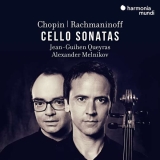Die beiden Buchstaben Alpha und Omega stehen zunächst für Anfang und Ende des alten griechischen Alphabets. Im übertragenen Sinn will man damit aber auch allgemein die Eckpunkte benennen oder ein Thema umgrenzen. Und darin steckt auch, dazu ist alles gesagt. Die beiden hier zu hörenden Sonaten sind so ein A & O, da in der Musik das Werk von Chopin die Romantik begründen mag und das von Rachmaninov an seinem Ende zu hören ist. Nicht wenig haben sich die beiden Interpreten also vorgenommen, wenn sie diese Eckpunkte zusammenführen.
Dass es bei ihnen nicht um technische Fragen geht, ist als gesetzt zu sehen. So ein Thema gibt es aber doch. Beide Komponisten waren Pianisten und haben herausfordernde Klavierparts komponiert. Bei Chopin führt die Notendichte im Klaviersatz z einer solchen Struktur, dass mit einem modernen Flügel das Cello beengt würde. Zu einem ausgewogenen Verhältnis kommt, wer einen zeitgenössischen Flügel, hier einen Erard, einsetzt. Dagegen findet ein Steinway bei Rachmaminov seinen Platz. Das Gioffredo Cappa Cello erklingt durchgehend.
Queyras und Melnikov sind ein eingespieltes Team. Sie widmen sich diesem Repertoire hingebungsvoll intensiv und mit großer Vertiefung. Dass dieses bei Rachmaninov dann auch die große symphonische Geste umfasst, ist inbegriffen. Was sie ihren Instrumenten alles an Schattierungen entlocken und wie sie mit Elan die Musik spielen, bietet ein reichhaltiges Angebot an Höreindrücken. Und es hat sich gelohnt, beim Klavier zweigleisig zu agieren. Der Klang bei Chopin wird durchhörbarer und auch damit lässt sich die Entwicklung von Chopin zu Rachmaninov verdeutlichen. Der Pole wirkt dadurch feiner, der Russe voluminöser.
Diese romantische Tapete gibt beiden dann auch die Gelegenheit, vor allem in langsamen Sätzen feingestaltet zärtlich zu agieren und die Musik dynamisch nuanciert anzureichern. Queyras und Melnikov kommunizieren in höchstem Maße und gehen beidseitig aufeinander ein. Dabei bleiben sie in den eingesetzten Stilmitteln in einem gepflegten Rahmen. Sie nutzen nicht etwa das vermeintliche oder wirkliche Romantische, um mit großer Bewegung eine Gestik vorzugaukeln, die auf diese Weise gar nicht, jedenfalls aus heutiger Sicht, zu erzielen ist. Beispielweise legt der Cellist sein Vibrato wahrnehmbar, aber nicht großspurig an.
Das sonst immer exquisit agierende Label Harmonia Mundi hat hier einen Schuss zu viel vollfette Sahne beigemengt. Die Idee war vermutlich, das Romantische auch in dieser Hinsicht heraus zu modellieren. Aber die Instrumente klingen etwas zu voll und zu nah für einen uneingeschränkt gesunden Hörgenuss. Das wäre nicht nötig gewesen.
The two letters Alpha and Omega stand for the beginning and end of the ancient Greek alphabet. In a figurative sense, however, they are also generally used to designate the cornerstones or to perimeter a topic. And in it is also, to it everything is said. The two sonatas to be heard here are such an A & O, since in the music the work of Chopin may establish the romanticism and that of Rachmaninov is to be heard at its end. So the two interpreters have set themselves no small task when they bring these cornerstones together.
The fact that they are not dealing with technical issues is to be seen as a given. But there is such a theme. Both composers were pianists and composed challenging piano parts. In Chopin, the density of notes in the piano part leads to such a structure that with a modern grand piano, the cello would be cramped. A balance is achieved by using a contemporary grand piano, in this case an Erard. In contrast, a Steinway finds its place with Rachmaminov. The Gioffredo Cappa cello is used throughout.
Queyras and Melnikov are a well-rehearsed team. They devote themselves to this repertoire intensively and with great depth. Of course this also includes the great symphonic gesture in Rachmaninov’s piece. What they produce from their instruments in terms of shadings and how they play the music with verve offers a rich listening impression. And it was worthwhile to take a two-pronged approach to the piano. The sound in Chopin becomes more audible, and this also illustrates the development from Chopin to Rachmaninov. The Pole seems finer, the Russian more voluminous.
This romantic background then gives both the opportunity to act tenderly, especially in slow movements, and to enrich the music with dynamic nuances. Queyras and Melnikov communicate to the highest degree and respond to each other on both sides. At the same time, they remain within a cultivated framework in the stylistic means they employ. They do not use the supposed or real romantic to pretend with great movement a gesture that cannot be achieved in this way, at least from today’s point of view. For example, the cellist applies his vibrato perceptibly, but not pompously.
The otherwise always exquisitely acting label Harmonia Mundi has added a dash too much full-fat cream here. The idea was probably to model the romantic in this respect as well. But the instruments sound a bit too full and too close for an unrestricted healthy listening pleasure. That would not have been necessary.
























